How To Draw Spiral Staircase In Sketchup
Engineering ToolBox - enabled for use with the amazing FREE SketchUp 3D drawing and modeling program.
Home > Stairs and Ladders >
Spiral Stair
Make your own spiral staircase
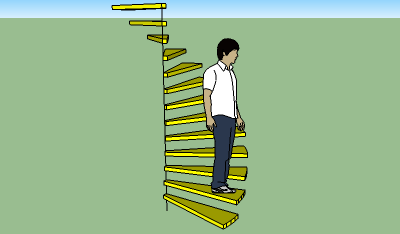
| Rise | |
| Rotation (degrees) | |
| Width | |
| no. of steps | |
| thickness of steps | |
| nosing projection | |
| Unit rise Elevation angle deg | |
| | |
| Insert! | |
Rotate the screen or widen the window to see full table!
Tip! Use the vertical and horizontal planes to position the stair - remove the planes after insertion.
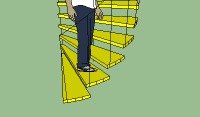
Add handrails and details for the stair by selecting and working on one step (all steps are instances of the same components).
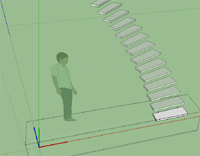
A larger inside radius can be achieved by using a larger width - modifying the unit step after insertion.
Privacy
We don't collect information from our users. Only emails and answers are saved in our archive. Cookies are only used in the browser to improve user experience.
Some of our calculators and applications let you save application data to your local computer. These applications will - due to browser restrictions - send data between your browser and our server. We don't save this data.
Google use cookies for serving our ads and handling visitor statistics. Please read Google Privacy & Terms for more information about how you can control adserving and the information collected.
AddThis use cookies for handling links to social media. Please read AddThis Privacy for more information.
Engineering ToolBox Sketchup Extension
Insert standard and customized parametric components - like flange beams, lumbers, piping, gemometric figures, function curves, stairs and more - to your Google SketchUp models with sketchup.engineeringtoolbox.com
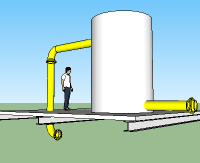
It's FREE and FUN!
Download SketchUp
If you don't have Sketchup installed on your computer - download the amazing FREE SketchUp here!
Note! - SketchUp Free and Sketchup Shop (the web apps) can't use extensions. You need to install a local version of SketchUp Pro (paid) or Sketchup Make 2017 (free) if you want to use the Engineering ToolBox extension.
Basic Use of the Engineering ToolBox Sketchup Extension
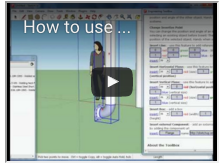
From within Sketchup - open the Engineering ToolBox extension, navigate to component and select insert! - and the component will be added to your model.
Watch basic use of the Engineering ToolBox extension in YouTube
How to add the Engineering ToolBox Extension to your SketchUp
Alt. 1 Sketchup Extension Warehouse
- Open your Sketchup installation
- From the Sketchup menu - select Window > Extension Warehouse - and search for "Engineering ToolBox" - and install!
- The extension can be enabled/disabled from the Sketchup menu Window > Extension Manager
Restarting Sketchup may be required to activate the extension.
Note that this procedure may be different in older Sketchup versions.
Alt. 2 Download the Extension
- Download engineeringtoolbox_tools_v1.0.4.rbz to a location on your computer
- Open your Sketchup installation
- From the Sketchup menu - select Window > Extension Manager, the button "Install Extension" - and select the downloaded file.
Restarting Sketchup may be required to activate the extension.
Note that this procedure is different in older Sketchup versions.
How to use the Engineering ToolBox Sketchup Extension
From the Sketchup menu - select Extensions > Engineering ToolBox. A page like this opens in a separate window - navigate to the wanted component - and select insert! to add the component to your SketchUp model.
Note! The SketchUp Engineering Toolbox is an online resource updated continuously. You need an internet connection to operate.
For some components parameters like length, color, offset and more can be modified before insertion.
Customized components can be inserted by changing parameters in the dialog boxes at the end of the component lists - and clicking "custom!"
Selected objects in the model can be manipulated - rotated, moved, colors changed and more - from the Tools section.
Assistant objects like lines, horizontal and vertical planes can be added.
Some Tips and Tricks
The most efficient way to learn SketchUp is by watching the tutorial videos.
Organize your model in groups - add components to the groups!
Example: Use separate groups for construction steel, piping, the different HVAC systems and more.
Always keep an eye on the model in the "Outliner" window.
Use layers to organize and control the visibility of the model.
The most convenient way to copy an object is by selecting it, using move or (m) and pressing Ctrl (makes a copy) before moving.
Use the rotation tool on this page to precise rotations of components like bends, pipes ...
Precise moving of a object can be done by selecting a point in the object that can be connected to a point in the new position (like a edge on a component, surface, a midpoint or similar).
Bill of Materials
Be aware that objects from The Engineering ToolBox are inserted in Sketchup as Groups. They will show up in the Sketchup > Window > Outliner dialog but not in the Sketchup > Window > Model Info > Statistics (Only Components) dialog.
If you want to make "Bill of Materials" from your model
- insert an object from The Engineering ToolBox
- select the object in the model (or in the Outliner) after insert
- click The Engineering ToolBox "Make Component"
The objects will now show up in the Sketchup > Window > Model Info > Statistics dialog and be available for reporting through Sketchup > File > Generate Report feature or other third party report generators.
An insterted object from The Engineering ToolBox can also be converted to a Component by right clicking the object and selecting Make Component. The name will not be preserved and must be changed after the conversion.
10 27
.
How To Draw Spiral Staircase In Sketchup
Source: https://sketchup.engineeringtoolbox.com/spiral-stairs-c_113.html
Posted by: robertsonbeirch1984.blogspot.com

0 Response to "How To Draw Spiral Staircase In Sketchup"
Post a Comment